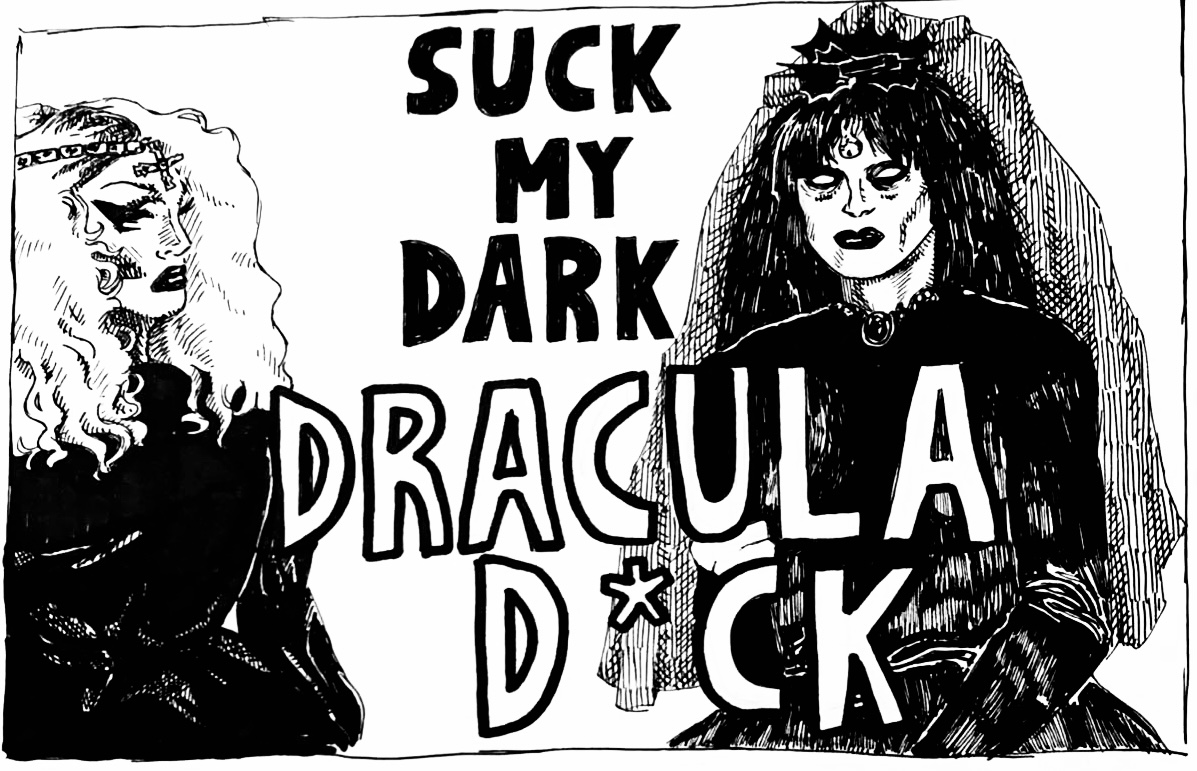
With Juno Birch, Sgaire Wood, and Charity Kase, Vogue's 'Extreme Beauty' series introduced me to the world of drag, so delving deeper into that became my next port of call. Not everything I cover for this chapter segment will be explicitly facial horror, but I consider everything that I discuss to be on topic for reasons I will explain later. In brief, for now, drag has a rich overlapping (oftentimes offensive, transphobic and queerphobic) history with horror. Drag is the cousin of Halloween.

"They say that Halloween is Christmas for drag queens." - Trixie Mattel ('UNHhhh Ep 29: "Halloweenie" w/ Trixie Mattel & Katya' on YouTube.)
I'm going to discuss four notable points at the intersection of drag and horror: 'RuPaul's Drag Race', 'Dragula', 'The Rocky Horror Picture Show', and 'Pink Flamingos'.
The first port of call will be most people's first (and maybe only) interaction with the world of drag, the reality TV show 'RuPaul's Drag Race' (2009-), which has fifteen seasons thus far. The show is a competition where drag queens show off their skills in areas such as costume design, modelling, and performance, for a grand prize of $100,000. It is hosted by RuPaul Charles, who gained notoriety as a famous drag queen and musician in New York in the 1990s. The show is U.S. based, but has numerous spin-offs running in other countries (Thailand, the U.K., and Canada, to name a few). 'Drag Race: All-Stars' (2012-) is another notable spin-off. Having run for eight seasons thus far, it features past contestants in a cross-season competition.
'Drag Race' is a good example straight off the bat as it serves to point out how referential drag is of pop culture. Although drag is countercultural (to a point) in that it is parodic of mainstream gender norms and is a type of performance originating in and largely for queer circles, mainstream film and television are often co-opted by drag performers for the sake of comedy or fashion (cyclical in the sense that the thing that is being co-opted is often warped to suit a queer sensibility, and the mainstream frequently co-opts things (yes, even drag) that originated as queer and makes them palatable and marketable). Horror is no exception.
Take for example the 'Drag Race me to Hell' acting challenge from s6e03: 'Scream Queens'. The contestants were split into two teams, both having to act in a spoof horror short called 'Drag Race me to Hell', featuring a haunted house and a severed head in a box. One team had the 'original' version of the short film, and the other were given the sequel/remake. Other horror themed challenges include things like the 'Monster Ball' from s11e05, or the 'Rumerican Horror Story: Coven Girls' acting challenge from 'All Stars' s6e06.
Raja Gemini in a 'Carrie' inspired look in 'RuPaul's Drag Race' s3e8 ('Ru Ha Ha!')
Horror themed runway looks are more common: near the end of most 'Drag Race' episodes, all of the contestants show off an outfit by modelling it with a runway walk on the main stage, in front of the judges.
Gottmik in a 'Hellraiser' inspired look in 'RuPaul's Drag Race' s13e16 ('Grand Finale')
Gottmik's 'Hellraiser' inspired outfit helps me solidify the idea that mainstream elements used in drag are 'drag-ified' and changed to suit queer sensibilities (although, to be fair, with 'Hellraiser', it doesn't take much). Gottmik is dressed as The Hell Priest (colloquially as Pinhead). The Hell Priest is a cenobite, creatures who were once human but through entanglement with demonic forces (putting it lightly, but I won't go into detail about it here as I want to in a further chapter), now don s&m gear and torture humans as they derive pleasure from it. In Clive Barker's 'The Hellbound Heart', the 1986 short story on which 'Hellraiser' is based, the cenobites are described thusly:
"Frank had difficulty guessing the speaker's gender with any certainty. Its clothes, some of which were sewn to and through its skin, hid its private parts, and there was nothing in the dregs of its voice, or in its wilfully disfigured features that offered the least clue." - 'The Hellbound Heart', Clive Barker, 1986, p8.
"Only these sexless things, with their corrugated flesh." - ibid. p9.
In the story, the cenobite's lack of discernible gender adds to their appearance as removed from humanity, in the same way their extreme and beautiful body modifications do. The reverse then, by this logic, is that to be gendered or sexed is to be human, and yet to many queers including drag performers, this is obviously not the truth. The answer, to the gender non-conforming, is to align yourself, in a tongue-in-cheek way, with the non-human, the evil, and the cenobites.
Asia O'Hara in a 'Creature from the Black Lagoon' inspired mermaid costume in 'RuPaul's Drag Race' s10e07 ('Snatch Game')
I like imagining, by this logic, that there is male, and female, and a larger misted area in the middle signifying the non-human. That drag performers who play the opposite sex have to cross this boundary time and time again, and that for a moment in between before getting ready and becoming their character, they are beyond human. I don't mean this in a derogatory way, as I find the idea beautiful, and even if I meant it as offensive, the idea is so ludicrous that it doesn't even deserve attention.
But still, it's in queer nature to co-opt the non-human and 'evil', outcasted and misunderstood characters in horror, often villains, who are outside of what is recognised in the mainstream as sympathetic. Carrie White and the Creature from the Black Lagoon make for good drag looks. Horror icons with queer subtext to their franchise too.
Crystal Methyd in a Freddy Krueger inspired 'fall collection' outfit, in 'RuPaul's Drag Race' s12e01 ('I'm That Bitch')
'Alternative' queen Sharon Needles ended up winning the competition in its fourth season, which is probably the most horror-centric the show has ever been, but Needles herself is not the sort of figure I want to promote - she is controversial and racist. I should also point out that, despite what I've written, 'Drag Race' is undeniably palatable to straight audiences and is an extremely mainstream take on drag (even though it was quite countercultural in its first few seasons, where challenges included sending drag artists out onto Hollywood Blv to harass pedestrians, and the RuPaul song 'Responsitrannity' was used liberally). Overall, the show is focused on polish and presentability. It tells humanist narratives. There is another drag reality competition show, this one focused on 'filth, glamour, and horror': 'The Boulet Brothers' Dragula' (2016-).
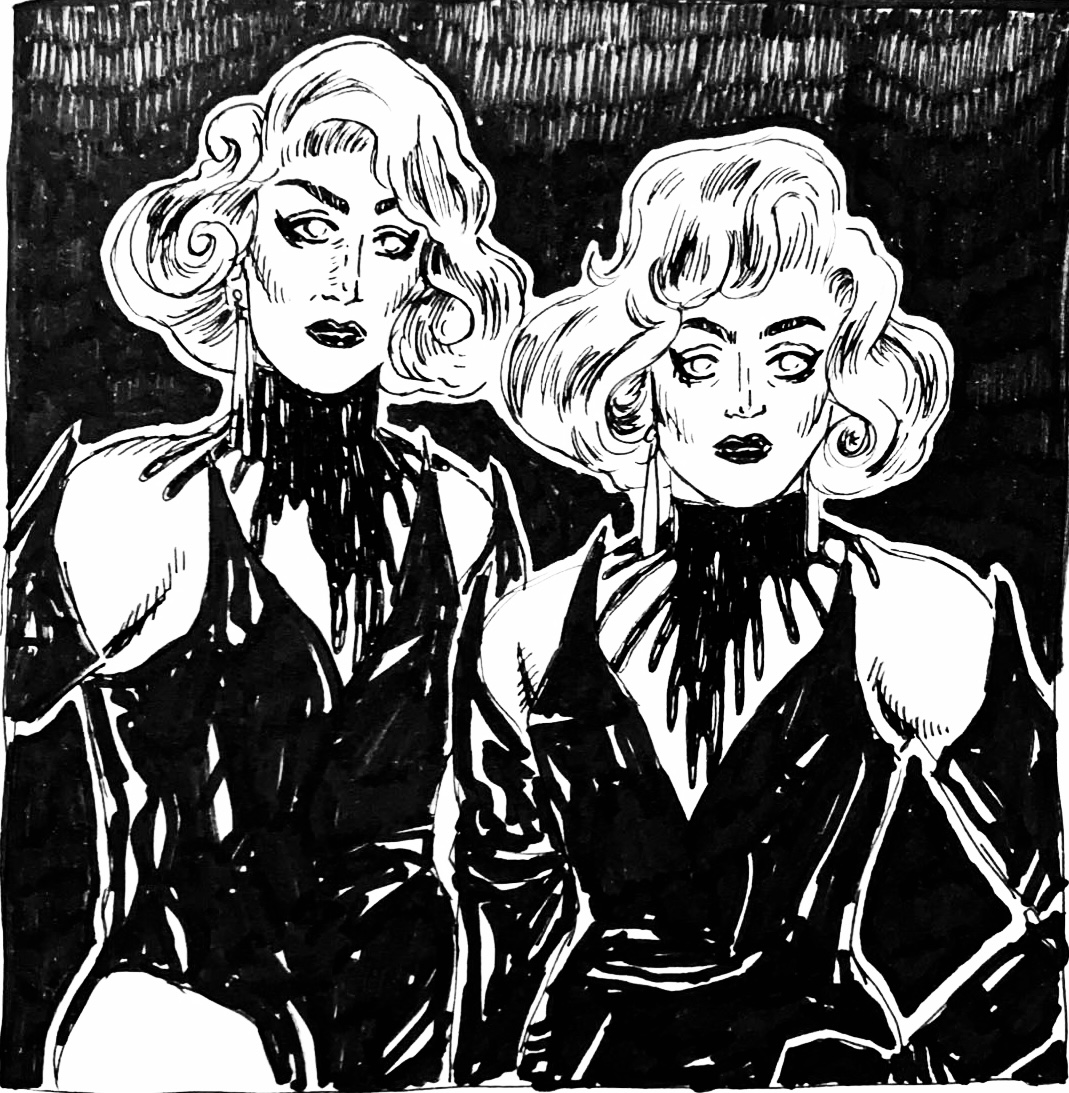
The Boulet Brothers
The fact that the show shares a name with a Rob Zombie song and is hosted by two drag queens whose characters are ultra-rich incestuous twin murderers should give you an idea of how it differs from 'Drag Race'. The show has had four seasons so far, and is based on the club event of the same name and hosts. The first season, the only main season I've watched, was a web-series with a crowdfunded cash prize, so the whole thing is available on YouTube. Its subsequent seasons have since moved to TV. There have been two 'Dragula' spin-offs, akin to 'All Stars' in that they feature past competitors: 2020's 'The Boulet Brothers' Dragula: Resurrection', which was a single episode Halloween special, and which I have seen, and a nine-episode season, 'The Boulet Brothers' Dragula: Titans', which I have not.
The show highlights alternative and underground drag with punk aesthetics. Some of the challenges in the first season included modelling a sea-monster outfit in the freezing cold ocean of the San Francisco Bay, eating brains, and being buried alive.
"Drag has blown up in the world, but only a certain sort of aesthetic has taken off, and it has left a lot of really creative and talented people feeling left behind. To us, we feel that it's almost a responsibility of ours to make sure that people know about all the different kinds of drag that there are, celebrate them, bring them out, and put them on display for the world to see." - Dracmorda Boulet ('The Boulet Brothers' Dragula', s1e6 ('DRAGULA: Season One Finale | Hey Qween' on YouTube).
'Dragula' is also ahead of the curve in terms of showcasing drag kings and non-binary performance artists, as well as so called 'bioqueens' (drag queens assigned female at birth), facets of the art which 'Drag Race' largely ignores.
Vander Von Odd being crowned the winner of season one of 'Dragula' and awarded the title of 'The World's First Drag Supermonster' ('DRAGULA: Season One Finale | Hey Qween' on YouTube).
The winner of 'Dragula's first season, and someone I idolised endlessly at the time of viewing, was Vander Von Odd. She was, and probably still is, the most beautiful thing in the world to me. I loved Vander so much that I watched the obscure show 'Night Gowns' solely for her performance in the fourth episode, in which she stapled paper hearts into her own skin, and onto her face. 'NightGowns', also highlighted drag that is outside of mainstream appeal. The show, headed by 'Drag Race' season nine winner Sasha Velour, focused on a different member of the cast of the 'NightGowns' stage show each episode. It had eight episodes and was an original show for the streaming platform Quibi, which is now defunct.
Vander Von Odd in 'NightGowns' episode 4 ('Vander Von Odd')
Then there's the 1975 Jim Sharman movie 'The Rocky Horror Picture Show', a campy b-horror musical about Dr. Frankenstein figure Dr. Frank-N-Furter, a female-lingerie clad mad scientist who is creating a would-be boyfriend, blonde muscle-bound Rocky. Frank-N-Furter and the skeleton staff at his castle (butler Riff-Raff and maid Magenta), are actually aliens from 'the planet Transsexual in the galaxy Transylvania'. The events of the film take place when quote unquote normal newlywed couple Brad and Janet seek refuge at Frank-N-Furter's castle during a storm after experiencing car trouble. They stumble upon the 'Annual Transylvanian Convention' (essentially a party of people in exaggerated drag-esque costumes). Frank-N-Furter introduces himself to Brad and Janet (via song) as a 'sweet transvestite' and invites them to watch him re-animate Rocky. Throughout the course of the film, he sleeps with both of them, gets mad when Janet sleeps with Rocky, and co-erces them into taking part in a cabaret floor-show before he is shortly betrayed by Riff-Raff and Magenta, who kill him for his decadence and return to Transsexual.
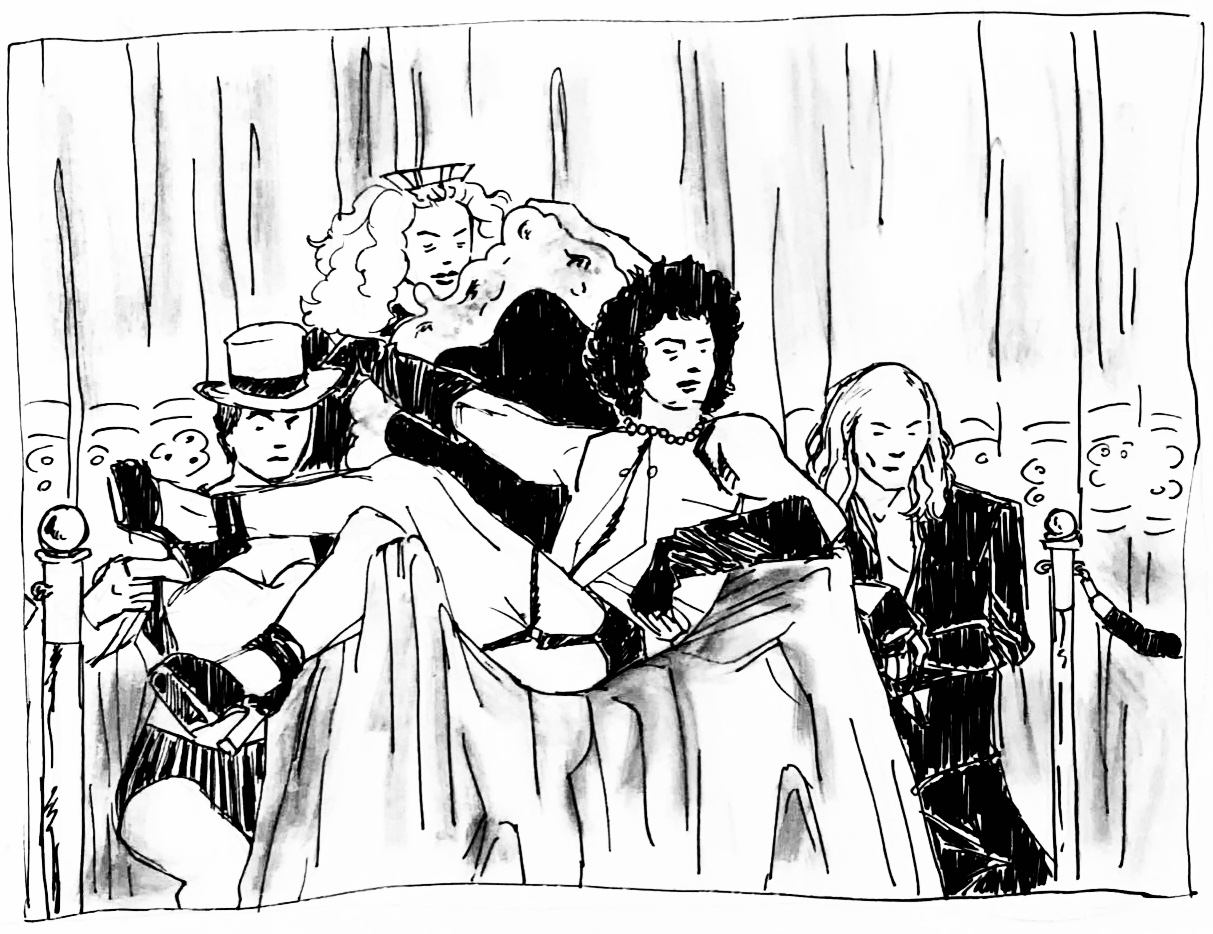
(Left to right) Columbia, Magenta, Frank-N-Furter, and Riff-Raff in 'The Rocky Horror Picture Show' (1975).
The film was adapted from the musical theatre production 'The Rocky Horror Show' which originated on the West End only two years prior. The long-running status of the musical, as well as the popularity of the movie in cult and midnight screening circles, means that audience participation is expected at most 'Rocky' iterations. Reportedly, people in attendance at performances/screenings dress as the characters and recite the dialogue as it is spoken, as well as invent their own. They throw things, or insult the characters (particularly Brad and Janet). People sing along and the whole thing is generally very lively and unorthodox. As an example, and coming from the mouth of my father, who went to an amateur and unauthorised performance in Newcastle, in the '80s: a group had wandered in from the street, clearly unknowing what the play was about, and, instead of laughing along with the rest of the audience, began to hurl slurs at the performers. The Frank-N-Furter, a Geordie himself, after becoming sick of it, abandoned the script and performance and descended from the stage to fight the hecklers, as the rest of the on-stage performers remained in character and egged him on. Classic Newcastle.
Dr. Frank-N-Furter.
The reason I bring up the participatory side of 'Rocky' screenings so heavily is because I think it is one of the things bearing the closest resemblance to sub-space without the potential danger of real sub-space. Sub-spaces are oftentimes inherently queer areas that provide most of the horror/surrealism/magic encountered in real life. Imagine reality as one of the strips of black on a bar-code- all of the black strips are in fact various realities, each with their own laws and norms. There are an infinite number of black strips, and this is a bar-code that goes on forever and ever. The white areas of this hypothetical bar-code (the gaps in between realities) are sub-space, completely without law or reason. There are places in the world where the walls between reality and sub-space are very thin naturally, or have been eroded over time, or have snapped/broken, and these places are when sub-space becomes apparent in this world, and things start to seem strange. Some people too, unbeknownst to them, carry tools of erosion or the potentiality to break within them. Sub-spaces within this world can be a positive or negative thing, or sometimes both. As a point, most instances of real-world face horror (ghosts, monsters, hallucinations, distorted reflections, tricks of the light, I could go on), are the result of sub-space within the world.
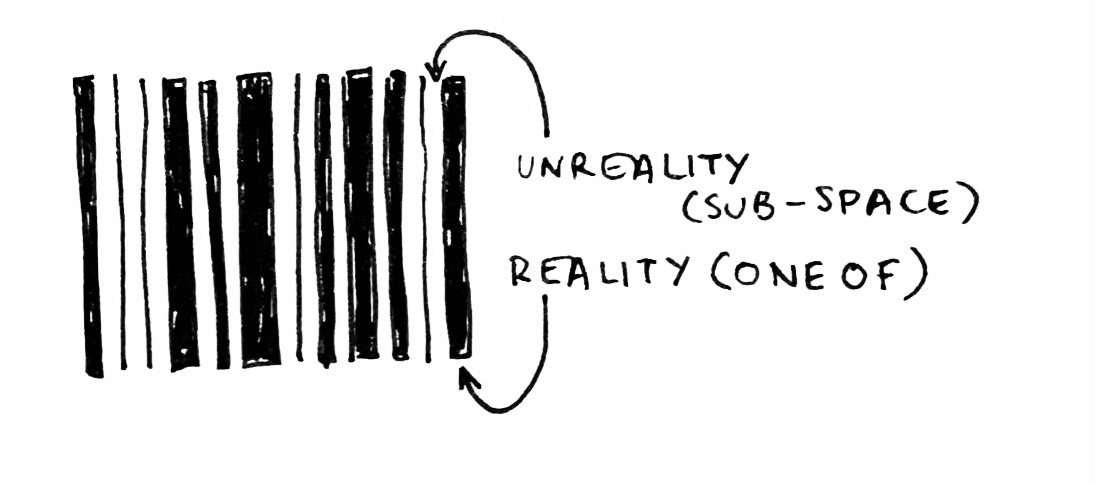
Bar-code sub-space diagram
Being a first-time attendee of a 'Rocky' midnight screening or amateur performance is to witness the surreal- a whole other queer nonsensical world. This experience paralleling the moment where Brad and Janet themselves first see the Transylvanians, and that people embody the characters through costume, alongside the 'real' versions of the characters who are in turn, fictional, signifies the collapse of distinction between reality and fiction, a breaking down of the barriers between worlds. For these reasons, the whole thing distinctly resembles an intrusion of sub-space.

Old 'Pink Flamingos' drawing (July, 2020) featuring (left to right) a reporter, Divine, Cotton, Connie Marbles, Raymond Marbles, and Crackers.
Lastly, there is John Waters' 1972 masterpiece 'Pink Flamingos', starring drag legend Divine and a host of other Waters movie regulars. In the movie, Divine is in hiding in a trailer in Baltimore, going by the name Babs Johnson. She finds her title of 'The Filthiest Person Alive' challenged by straight-couple caricature Connie and Raymond Marbles. These dyed-hair eccentrics make a living by getting their butler to impregnate kidnapped female hitchikers and adopting the babies out to rich lesbians. Divine and her 'son', Crackers, along with Divine's travelling companion Cotton, in between coping with Divine's egg-obsessed and play-pen bound obese mother, go head-to-head with the Marbles in a bid to 'out-filthy' them. Eventually, they capture and publicly execute Connie and Raymond in front of a host of reporters.
It's totally unpalatable queer representation. Divine plays chicken with pedestrians for fun. She keeps raw steak fresh by putting it, uh, up between her legs. Her birthday party, where she is gifted a meat cleaver wrapped in a bow and is entertained by a man with a singing butthole, devolves into cannibalism. In the notorious final scene of the film, Divine proves to the world just how filthy she is by literally eating dog shit (in real life, unsimulated. In every sense of the word, she did it for real).
(left to right) Cotton, Divine, and Crackers in 'Pink Flamingos'.
"Divine, are you a lesbian?"
"Yes- I have done everything."
"Does blood turn you on?"
"It does more than turn me on, Mr. Vader, it makes me come. And more than the sight of it, I love the taste of it- the taste of hot, freshly killed blood."
"Could you give us some of your political beliefs?"
"Kill everyone now! Condone first-degree murder. Advocate Cannibalism. Eat shit! Filth are my politics- filth is my life!" - An interaction between Divine and reporters in 'Pink Flamingos' (1972).
'Pink Flamingos' is rotten, but not without good reason. Waters has delivered a kind of provocative statement about queer life in the '70s: "You think we're dirty- I'll show you dirty!" The result is something that estranges most straight and even some queer viewers. The film, however, is undoubtedly a comedy. Comedy of errors, maybe, with the bad acting, and poor-taste jokes, but the film is not trying to be scary, merely off-putting in a gross-out humour type of way.
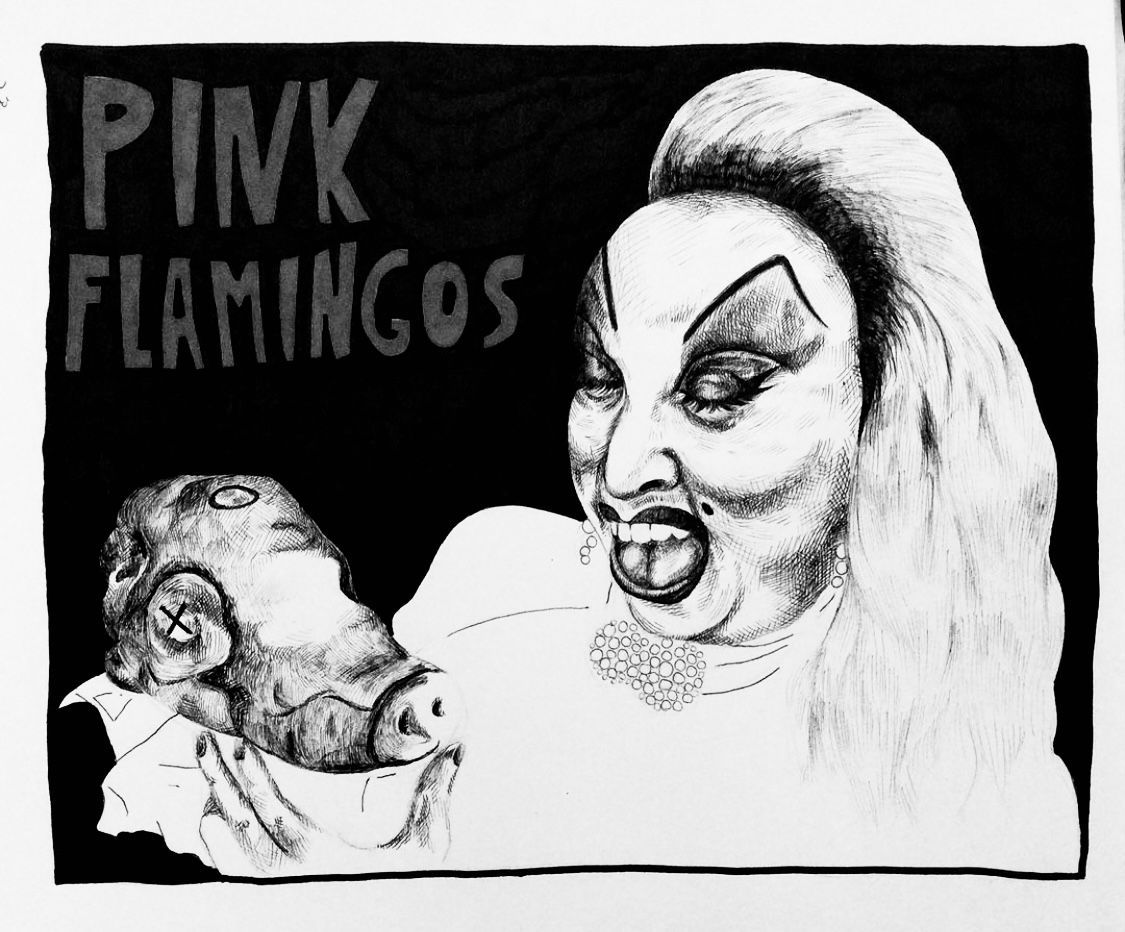
Old drawing of Divine in 'Pink Flamingos' (April, 2020).
Here's something I'll never get over: it seems that the queer person's subcultural comedy is the straight person's horror. Do you remember that quote unquote disturbing movie iceberg that went viral a few years ago? The one with 'Pink Flamingos' nestled among titles such as 'Salo, or the 120 Days of Sodom', 'The Human Centipede 2 (Full Sequence)', and 'A Serbian Film'? You might wonder why 'Pink Flamingos' is as disturbing as the out and out horrors it's tiered up against. You might take a look at the rest of the iceberg and note that all of the other entries are horror movies or mondo shockumentaries. This is because, before it went viral under the more fitting category of 'Disturbing Movies', it was originally penned as an iceberg chart for 'Horror Cinema'. Little old drag queen Divine, up against slasher infamy, and Lucifer Valentine. The horror hall of fame- Myers, Krueger, Vorhees, and of course, Divine eating dog poo.
But drag is a cause for horror, so much so that drag conventions are baked into the genre- so I can forgive the mislabelling. To get to the crux of the matter and the reason for this chapter, I want to abridge Carol J. Clover's 1993 book (and firm friend to me) 'Men, Women, and Chainsaws: Gender in the Modern Horror Film'. The point of the first few chapters, particularly those concerning slasher films, is to highlight the exaggerated gender performance (the drag art) of slasher killer men and the final girl, and how, in conflict, the two merge and become something more. That the killer, while the ultimate display of heightened masculinity, is brought to weakness at the hands of the final girl, and is then shown to be not a whole man (because he is a monster, or stunted in some other way). That the final girl has to metaphorically don his robes by meeting him at his level, not opposed to violence as a means to survive. Clover mentions that the final girl often has a boyish name (Ripley, Laurie) and is distinguishable from her more gender-typical female peers not only because she is willing to go the extra violent mile to survive, but because she is not sexually promiscuous, and she is often competent in a masculine hobby. This androgyny of sorts, brought out in a life-or-death conflict, is what allows her to survive, and, although Clover doesn't say this, I would suggest that the deeper understanding of the killer as not-quite-a-man, him being bested by her, is what enables him to survive and come back time and time again. Round and round for another sequel. The two are a match made in hell. The backbone of horror is a gender crisis, the facade and exaggeration of drag in all but name.
A scuffle in the place between life and death, man and woman.
"It is a universe, in other words, of slippage and fungibility, in which maleness and femaleness are always tentative and hence only apparent." - Carol Clover, 'Men, Women, and Chainsaws: Gender in the Modern Horror Film' (1993), p14.
"The world of horror is in any case one that knows very well that men and women are profoundly different (and the former are vastly superior to the latter) but one that at the same time repeatedly contemplated mutations and slidings whereby women begin to look a lot like men (slasher films), men are pressured to become like women (possession films), and some people are impossible to tell apart (…)" - ibid. p15.
I find things like 'Drag Race' trite in comparison.